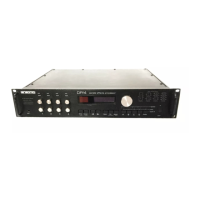Section 2 — Algorithms
86 ENSONIQ DP/4+ Reference Manual
SMALL PLATE
A plate reverb takes the vibrations from a metal plate and uses them to create a metallic sounding
reverb. Small plate reverbs are most often used in the studio for drums and percussion. Small
Plate is a tight sounding plate reverb
Small Plate Signal Routing
Right
Diffuser
Diffuser
L
LPF
Main
Outputs
Left
LPF
R
Definition
(Decay Diffuser)
Definition
(Decay Diffuser)
The internal values of the components (not user programmable) differentiate the large and small
plate reverbs. The signal goes directly through the diffusers which smear the signal. The signal
is then routed to a larger decay diffuser, known as Definition, and is diffused over a period of
time (creating a decay). The signal is then routed to the output, and then goes through a low pass
filter. There is a parameter that controls the decay time of both the left and right signals (shown
as triangles above). This signal is then routed back into the definition. There is also an external
dry signal (not shown) that goes directly from the input to the output and is controlled with the
mix parameter (01).
01 — Mix
02 — Volume
See the descriptions under the Mix and Volume Parameters, found earlier in this section.
03 — Decay Range: 0.20 to 100.0 sec.
Controls the amount of time it takes for the reverberation to decay. Percussion sounds best using
the Small Plate. High values of decay sound good on these algorithms.
04 — Predelay Time Range: 0 to 500 ms
Controls the amount of time it takes for the input signal to be presented to the plate reverb. A
value of 0 would offer no delay.

